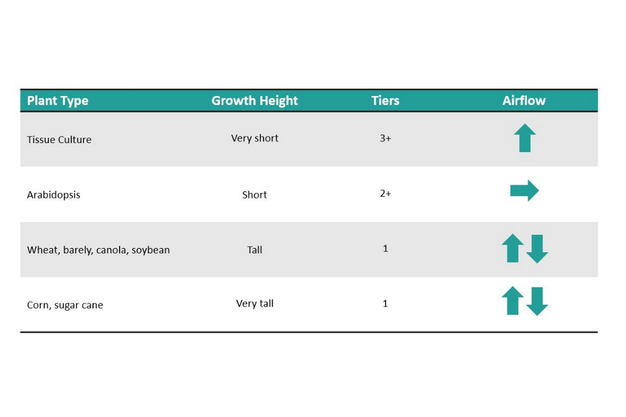Conducting successful plant science research in plant growth chambers hinges on the ability to precisely manipulate and replicate specific environmental factors—such as light, temperature, humidity, and CO2. Airflow in plant growth chambers also plays a critical role, facilitating consistent climate control throughout the growing space and exerting a profound impact on the photosynthesis, water loss, morphology, physiology, and reproduction of the plant.
Without proper airflow, plants within the same chamber can end up exposed to different conditions that compromise research reliability and hinder the insights gained from a given experiment. In this Insight, we'll explore the role of airflow in plant growth chambers in more detail, including what's already known and what needs to be researched further in order to leverage its full potential as a contributor to successful plant growth chamber operations.
Understanding airflow in a plant growth chamber
Airflow in a plant growth chamber refers to the controlled movement of air within an enclosed environment. It ensures that air circulates evenly throughout the chamber. By endeavoring to simulate air movement that plants may experience naturally in the wild, it helps create a stable and consistent environment, which is crucial for optimal plant growth and accurate research outcomes.
Airflow is important in controlled environment research for:
Creating uniform environmental conditions
Uniform airflow is vital for ensuring that each plant within the growth chamber experiences the same environmental conditions. This uniformity is crucial in scientific research, as it allows for the isolation of identified experimental variables.
Without consistent airflow, some plants may receive more or less of a particular condition, such as more or less temperature or humidity, leading to skewed results. By maintaining uniform conditions, researchers can ensure that any differences in plant growth are due to experimental conditions and not unintentional variability.
Facilitating gas exchange and transpiration
Proper airflow facilitates essential physiological processes in plants, such as gas exchange and transpiration. Air movement across plant surfaces helps to remove excess humidity and provides a consistent supply of carbon dioxide, which is necessary for photosynthesis.
Preventing microclimates
Microclimates are small areas within the plant growth chamber where conditions can vary significantly from the rest of the environment. For example: Lights give off heat that can create warmer spots within a growth chamber if airflow doesn't combat it. Controlled airflow prevents the formation of microclimates by ensuring that air is evenly distributed throughout the chamber.
This even distribution helps in maintaining consistent conditions, ensuring all plants receive the same treatment throughout the growth space and creating optimal experimental conditions.
What are the different kinds of airflow?
Different types of airflow are employed in plant growth chambers depending on the specific needs of the plants and the design of the chamber. Each airflow type has its own unique advantages and applications. The diagram below provides a general guideline:

Upward Airflow
In an upward airflow system, air is circulated from the bottom upwards. This method is often used in chambers where plants are grown in pots placed directly on the floor. The upward movement of air helps to ensure that all parts of the plant, from roots to leaves, receive consistent environmental conditions.
However, this type of airflow can be obstructed if pots or other objects block the air, which can lead to less uniform conditions within the chamber.
Upward airflow designs in plant growth chambers are commonly used for tissue culture research. Without it, condensation can form on the underside of each petri dish lid. Excess condensation can block the view of the materials inside the dish, block light from entering the dish causing inconsistent results, drop moisture on the samples inside the dish and create a water-soaked micro-environment, and interfere with photo documentation and other data collection.
The following video is an example of a plant growth chamber with uniform vertically directed airflow:
Horizontal airflow
Horizontal airflow moves air laterally across the chamber. This type of airflow is used in specific research applications and certain plant configurations, such as vertical farming. However, it can sometimes lead to uneven airflow if the plants or other structures obstruct the path of the air.
The way plants are arranged within a chamber can also play a significant role in optimizing airflow. For example, when plants are crowded too closely together, airflow can be hindered and some plants further away from the air source may end up with stagnant air or in a warmer microclimate.
Downward airflow
Downward airflow involves circulating air from the top downwards. Downward airflow is highly flexible and is generally considered quite a desirable type of airflow pattern for growth chambers as it can be widely used for a variety of plant types and research applications.

Above is an example of a downward airflow plant growth room. Wall plenums draw the air from the bottom of the chamber and discharge it from the top diffusers. The resultant mixture of additive gases in moving air is rapid and there is high uniformity throughout the growing space independent of plant loading.
Is velocity important?
Velocity of airflow in plant growth chambers is essential for adequate gas exchange and preventing stagnant air zones. This movement of air helps to maintain consistent temperature and humidity levels, ensuring that each plant receives the necessary environmental conditions for optimal growth. Leaf fluttering, while not a very scientific measure, is often used as a subjective visual indicator that airflow velocity may be appropriate.
Some experimental evidence also suggests that specific airflow velocities can impact optimal plant growth and health in different conditions. Plant growth chamber manufacturers, together with research partners at Universities and research institutes are using client feedback and data to learn more about how velocity can play a role in this way.
For now, it is important to keep airflow in mind when selecting a plant growth chamber and/or planning a research experiment. Ensure that the chamber design can support the intended research while providing effective airflow throughout the space.
Looking ahead
It's clear that airflow plays a critical role in controlling environmental factors that impact plant growth and research success. That said, there is still much to be learned about exactly how it can be leveraged intentionally to improve research and plant growth outcomes.
Plant growth chamber manufacturers have taken steps to stay on the cutting edge of new discoveries in this realm, facilitating partner research to uncover new insights about airflow in plant growth chamber design that can be applied to product development and client research planning.
As more is discovered, there will no doubt be opportunities to improve plant growth chambers to drive even more consistent and reliable results across research applications and other use cases.
For more information:
Conviron
www.conviron.com
